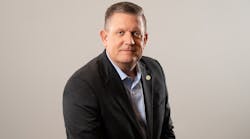Latest from Executive Insights & Interviews
Executive Insights with Bruce Moore, CEO, Highline Midwest
Topic: Advocating for Rural Providers
You’ve done significant work advocating for the needs of Michigan communities that are underserved.
ISE: Share some of the unique challenges you face in terms of network deployments, labor challenges, supply chain and ROI. What can the industry do to help other providers (and you, of course) with those challenges in the future?
Moore: Highline Midwest is an example of an RDOF award winner that is living up to its responsibility to serve its unserved households. Our thousands of subscribers live in very rural, agricultural terrain where it’s challenging to deploy fiber underground. This translates to 1,000s of right-of-way miles that were never permitted for fiber construction.
The key to fiber deployment success is developing relationships with County Road Commissions and mapping out how best to construct a network that will pass an average of 8 homes per mile.
Another challenge we face is the scope and expansiveness of our tasks given a construction window that is very short due to weather. We also require construction significant resources like plows, drills, etc. to accomplish our goal of constructing 1,000 miles each season.
“How can our industry fulfill the promise of Internet to all? We ALL need to be good stewards of funding from any sources. Only when we are good stewards and deliver on our promises should we be eligible for future funding.”
Topic: Hearing Your Customer
ISE: What do your customers expect? And what do your potential customers call you about the most?
Moore: Reliability is what customers expect. Streaming is cool but reliability is priority one. Fiber brings a new level of reliability expectation. Even though Highline is providing the fastest Internet they have ever experienced, tolerance for any network outage is low. Our potential customers can’t help but ask, “When are you getting here?”
It’s tough matching customer interest with the ability to build a rural fiber network fast enough! They want it today and we have to communicate longer timelines. Managing expectations is an art and a science.
Topic: State Support for Fiber Deployments
This summer, Lt. Governor Gilchrist visited Ford River Township to see some of the network elements you’re employing to deliver gigabit speeds to Michigan’s rural communities. The PR on your website shared the following: “Bruce Moore, CEO of Highline Midwest, has been promoting the growth of Broadband in Michigan to all townships, counties, and political advocates to ensure that they understand that Highline is willing to build to every county with the help of additional Michigan grant money that will be available this year, and subsequent years. Having the infrastructure in place and connecting to a core network means that expansions into additional counties is easier for Highline than a new entity coming in and having to start their construction from scratch.”
ISE: What will Highline do related to network transformation to secure those funds? What preparation is necessary to prove your ability to scale in rural areas?
Moore: We need to offer education, education, and more education to the community stakeholders. We need to educate them about Highline’s current obligated areas and how we are positioned to extend our network more efficiently and cost effectively with additional grant funds and public private partnerships.
We also must communicate that the initial network we are building for RDOF is designed for future scalability. With the changing definition of unserved households and future federal and state grant opportunities, Highline is well positioned to efficiently invest these grant dollars to immediately serve the households which were not included in the RDOF program. Because of poor mapping, many non-RDOF households are literally across the street! We embrace the plan of Internet for All!
Finally, we must over-communicate about how our network is designed to offer 1 Gig symmetrical services for the future multi gig needs of consumers and businesses.
Topic: Fiber Deployment
Aggressively deploying fiber across rural communities is no easy, nor cost-efficient, task.
ISE: What are two of Highlines best practices you can share with other providers on a mission to help their communities?
Moore:
- Spend the time to create a network that is capable of delivering a reliable IP address. And provide the customer premise router to provide the services. As I said before, Wi-Fi is the Internet in the minds of consumers!
- Invest in pre-construction due diligence to fully understand the route miles of fiber placement.
Topic: Priorities
ISE: What are two of Highline’s network-related priorities for 2023?
Moore: Continue deploying IPv6 addresses and continue our 2022 priority of network redundancy.
Topic: BEAD Funding – A Burdensome Process?
Recently the Senate Commerce Committee argued that rules regarding fund release requirements around pricing, labor and technology requirements are arduous and go against the intent of the program. Fierce Telecom reported that members of the committee shared their concern over certain requirements being unnecessarily burdensome on the states and service providers receiving the money. (Source: https://www.fiercetelecom.com/telecom/more-dozen-senators-press-commerce-chief-rethink-bead-rules)
ISE: Share your opinion about this.
Moore: It is a challenging proposition for government agencies to determine timelines on building a reliable fiber network. Realities of the construction process can’t be viewed in a theoretical manner. They must be rooted in reality because each build is unique. There is no broad-brush solution.
Topic: Labor Shortage
The US telecommunications industry employs a total of 672,000 workers, with average annual wages of $77,500. It’s forecasted that 5G rollout and other technologies could create 850,000 more "new direct broadband and 5G jobs" through 2025.
ISE: Clearly our industry needs workers. How can we attract and retain field talent in the future?
Moore: High schools, community colleges and traditional skill centers are now offering telecommunications trade skills courses that focus on fiber splicing and installation. As Communications Service Providers (CSPs), our job is to create mutually beneficial relationships with these organizations and then share job openings that pay well and offer great culture. This type of community collaboration will create a workforce for future industry demands.
Topic: In-Home Network Reliability
Consumers want higher-speed in-home networks. They also want high network reliability and low latency so their smart home devices controlling home security, climate or even sprinkler systems are not at risk. Toward that end, some CSPs and MSOs say their goal is to make Wi-Fi as reliable as a hardwired connection.
ISE: What is Highline doing to make this a reality?
Moore: Consumers believe that Wi-Fi IS the Internet. Therefore, we must provide state-of-the-art Wi-Fi 6 routers and applications with advanced home management and security features.
Topic: Your Forecast for 2023
ISE: What’s your crystal ball saying will be most important to Highline’s success in 2023?
Moore: We are on a mission to serve the unserved households in our serving area. We will continue with our plan to pass 8 homes per mile with fiber and aim to complete that by the FCC deadline in 2027.
How can our industry fulfill the promise of Internet to all? We ALL need to be good stewards of funding from any sources. Only when we are good stewards and deliver on our promises should we be eligible for future funding. This is where state and federal grant programs should support proven CSPs that have delivered on their commitment to connect communities.
Topic: Proactive Network Management
ICT industry analysts and observers often focus on service providers’ CAPEX budgets. But the reality is that OPEX can make or break a providers’ bottom line. The key to controlling OPEX is to improve network life cycle management for complex fiber and legacy networks in a cost-efficient manner.
ISE: What are some proactive approaches you recommend to control OPEX?
Moore: Hiring staff who are closest to the customer and negotiating cost effective backhaul connectivity.
Topic: Vendor Collaboration
ISE: What three things do you need from your vendor partners?
Moore: Reliability, high level support, and software upgrades that keep up with the pace of our business.
Topic: The Elephant in the Room
ISE: What is the industry NOT addressing that it should related to network evolution and broadband for all?
Moore: Building optical networks today for future bandwidth demands of residential customers.
Topic: Retaining and Retraining Top Talent
The great resignation is not ending. How does your team hold onto professionals with the most talent and the greatest work ethic when they must upskill to remain relevant? (Oftentimes, “upskilling” translates into working their day job and at the same time learning new skills for the future.)
ISE: Share your thoughts about the “rub” of this reality to employers AND employees.
Moore: Four principles we embrace:
- Let the talented people perform at a high level!
- Don’t micromanage.
- Reward employees based on the success of the company.
- Remember to say Thank You.
“Reliability is what customers expect. Streaming is cool but reliability is priority one. Fiber brings a new level of reliability expectation. Even though Highline is providing the fastest Internet they have ever experienced, tolerance for any network outage is low.”
Topic: Team Members
ISE: What’s the primary concern of your team members for 2022 and how are you addressing it?
Moore: They express concerns about managing work and creating a work/life balance (managing work/life balance). The way we help is to ensure they understand the vision of the company and their role in the grand scheme of that vision.
Topic: Advice
ISE: What would you tell emerging leaders as they try to make a difference in the industry AND propel their career to the next level?
Moore: Treat others as you’d like to be treated. Always do your best to bring level-headed leadership to your team.
ABOUT BRUCE MOORE
As Highline’s Midwest CEO, Bruce is responsible for the leadership of Highline’s FTTH business plan and team that delights customers with life-changing Internet service. His 34-year telecommunications career started with Century Telephone introducing dial-up service in 1996, Bresnan Cable Television launching cable modem service in 1998, leading a WISP in one of the nation’s first fixed wireless deployments beginning in 2005, and now leading Highline’s FTTH Midwest business starting in 2021. When not helping resolve the rural Internet problems in Michigan, Bruce enjoys golf and is a 25-year registered high school basketball official. For more on Highline, visit https://highlinefast.com/. Follow them on Twitter @Highline_Fast, Facebook: https://www.facebook.com/HighlineInternet/ and Instagram: https://www.instagram.com/Highline_Internet/.

Sharon Vollman | Content Ambassador for ISE EXPO
Sharon Vollman is the Content Ambassador for ISE EXPO. She is passionate about collaborating with thought leaders, SMEs and hard-working doers who design, plan and deploy ultra-reliable broadband networks. Vollman is committed to creating a variety of educational offerings for ISE EXPO attendees that inspire them to connect every U.S. citizen with the broadband networks we all want for our children and grandchildren.
Vollman has created educational partnerships with Broadband Service Providers including AT&T, Verizon, Lumen, Frontier Communications and others. She has covered the telecom industry since 1996.






